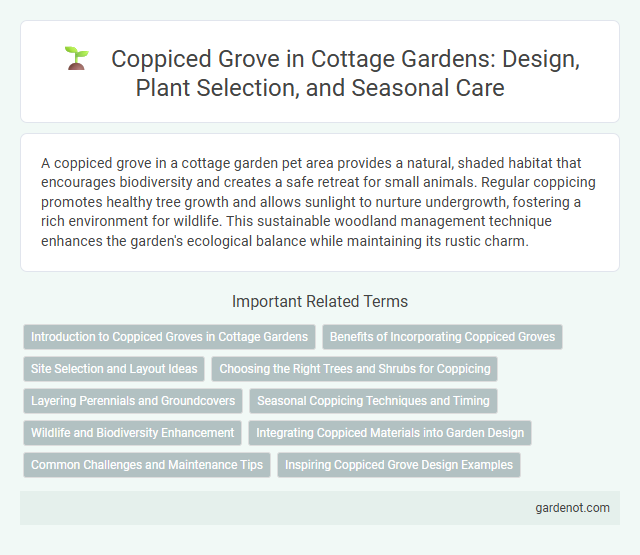A coppiced grove in a cottage garden pet area provides a natural, shaded habitat that encourages biodiversity and creates a safe retreat for small animals. Regular coppicing promotes healthy tree growth and allows sunlight to nurture undergrowth, fostering a rich environment for wildlife. This sustainable woodland management technique enhances the garden's ecological balance while maintaining its rustic charm.
Introduction to Coppiced Groves in Cottage Gardens
Coppiced groves in cottage gardens are managed woodlands where trees are periodically cut back to stimulate new growth, creating a sustainable source of timber and firewood. This traditional practice enhances biodiversity by encouraging a variety of understory plants and wildlife habitats, making coppiced groves both functional and ecologically valuable. Integrating coppicing into cottage garden design promotes natural cycles and supports the overall health of the garden ecosystem.
Benefits of Incorporating Coppiced Groves
Incorporating coppiced groves into a cottage garden promotes biodiversity by creating diverse habitats that support a wide range of wildlife, including pollinators and birds. The sustainable harvesting of wood from coppiced trees provides renewable materials for garden structures, fuel, and crafts, reducing environmental impact. Coppiced groves enhance soil health through improved nutrient cycling and increased organic matter, contributing to a thriving and resilient garden ecosystem.
Site Selection and Layout Ideas
Choose a sheltered site with well-drained soil for a coppiced grove to ensure healthy regrowth and sustainable yield. Design the layout with evenly spaced stools in a grid pattern, allowing sufficient sunlight and air circulation to foster vigorous shoots. Incorporate pathways and access points for easy harvesting and maintenance while preserving the natural aesthetic of the cottage garden.
Choosing the Right Trees and Shrubs for Coppicing
Selecting the right trees and shrubs for a coppiced grove is essential for sustainable growth and aesthetic appeal in a cottage garden. Species such as hazel (Corylus avellana), ash (Fraxinus excelsior), and willow (Salix spp.) are ideal for coppicing due to their vigorous regrowth and versatility. Incorporating native plants suited to local soil and climate conditions enhances biodiversity while providing materials for fencing, firewood, and crafts.
Layering Perennials and Groundcovers
In a coppiced grove within a cottage garden, layering perennials and groundcovers creates a dynamic, textured landscape that enhances biodiversity and soil health. Shade-tolerant perennials such as hostas and ferns thrive beneath the coppiced trees, while low-growing groundcovers like creeping thyme and ajuga suppress weeds and retain moisture. This stratified planting strategy maximizes space and fosters a resilient ecosystem that supports pollinators and enriches the garden's natural rhythm.
Seasonal Coppicing Techniques and Timing
Seasonal coppicing techniques in a cottage garden involve cutting back trees or shrubs to ground level during their dormant period, typically late winter to early spring, to encourage vigorous new growth. Proper timing is crucial, with most coppicing performed before the sap rises to reduce stress and promote healthy regrowth. This method boosts biodiversity by creating diverse habitats and ensures sustainable wood harvesting for garden use.
Wildlife and Biodiversity Enhancement
A coppiced grove in a cottage garden significantly boosts wildlife habitats by creating varied light conditions that support diverse plant species and attract insects, birds, and small mammals. Regular coppicing promotes dense undergrowth, offering shelter and nesting sites that enhance biodiversity within the ecosystem. This sustainable woodland management practice helps maintain ecological balance by encouraging natural regeneration and supporting native flora and fauna populations.
Integrating Coppiced Materials into Garden Design
Integrating coppiced materials into a cottage garden design enhances sustainability by utilizing renewable resources such as hazel, willow, or ash. These materials provide natural fencing, supports for climbing plants, and woven structures that add rustic charm and texture. Regular coppicing encourages biodiversity and supplies a steady flow of organic material to maintain garden aesthetics and functionality.
Common Challenges and Maintenance Tips
Coppiced groves in cottage gardens often face challenges such as uneven regrowth, pest infestations, and soil compaction. Regular maintenance involves timely cutting cycles, removing deadwood to prevent disease, and monitoring for invasive species. Proper mulching and controlled grazing enhance soil health and promote vigorous, sustainable coppice growth.
Inspiring Coppiced Grove Design Examples
Coppiced groves in cottage gardens showcase sustainable woodland management by regularly harvesting trees to encourage new growth, creating layered textures and dappled sunlight that enhance garden ambiance. Inspiring coppiced grove designs incorporate native species like hazel, willow, and hornbeam, promoting biodiversity and offering seasonal interest through varied foliage and wildlife attraction. Thoughtful layout and maintenance of coppiced groves provide natural screening, habitat corridors, and rustic focal points that blend seamlessly with informal garden styles.
Coppiced grove Infographic

 gardenot.com
gardenot.com